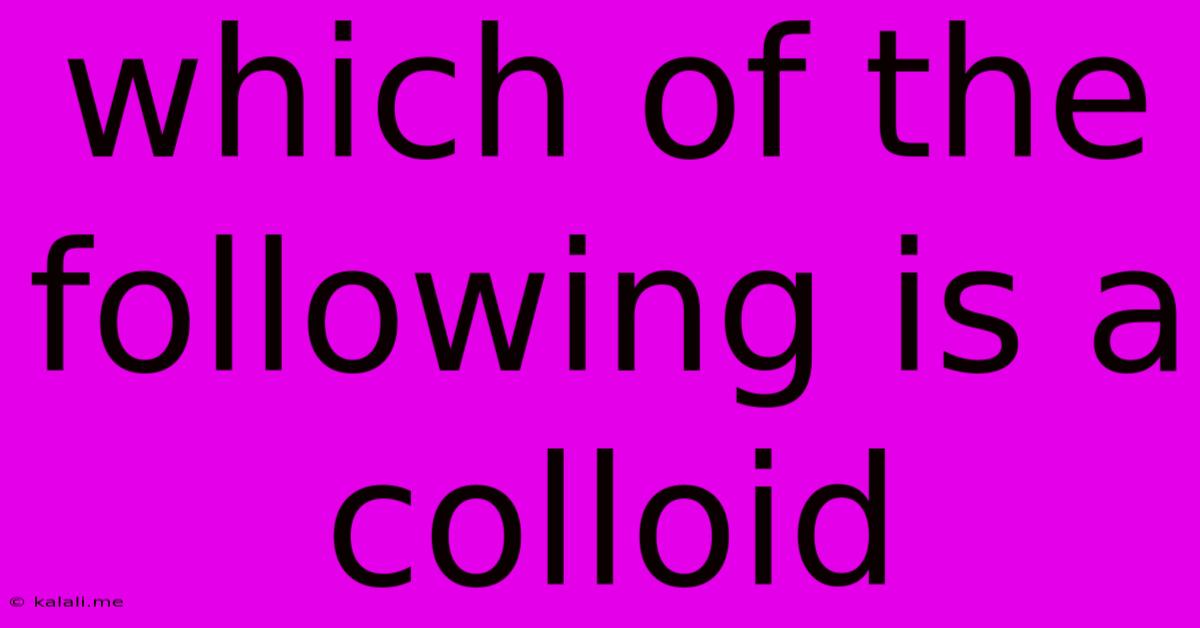Which Of The Following Is A Colloid
Kalali
Jun 15, 2025 · 3 min read

Table of Contents
Which of the Following is a Colloid? Understanding Colloidal Dispersions
Colloids are everywhere, from the food we eat to the products we use. Understanding what constitutes a colloid is crucial in various fields, from chemistry and materials science to food science and medicine. This article will delve into the definition of a colloid and help you determine which substances qualify as one. We'll examine the characteristics of colloids and compare them to solutions and suspensions to clarify the distinctions.
What is a Colloid?
A colloid is a mixture where one substance is dispersed evenly throughout another. However, unlike solutions where the dispersed particles are extremely small (ions or molecules), colloids have particles that are significantly larger, ranging from 1 to 1000 nanometers in diameter. These particles are too large to dissolve but too small to settle out easily. This characteristic is key to identifying a colloid. Think of milk, for instance – the fat globules are dispersed throughout the water, creating a stable mixture.
Key Characteristics of Colloids:
- Particle Size: The defining feature of a colloid is the size of its dispersed particles, falling within the nanometer range (1-1000 nm).
- Heterogeneous Nature: While appearing homogeneous at first glance, colloids are actually heterogeneous mixtures. The dispersed particles are distinct from the dispersing medium.
- Tyndall Effect: Colloids exhibit the Tyndall effect, scattering light beams passed through them. This is because the particles are large enough to scatter light. Solutions do not show this effect.
- Stability: Colloidal dispersions are relatively stable; the dispersed particles do not settle out easily due to their small size and often the presence of stabilizing agents.
Differentiating Colloids from Solutions and Suspensions:
To understand what makes a colloid, it's important to compare it to solutions and suspensions.
- Solutions: Solutions have particles smaller than 1 nanometer. They are homogeneous mixtures where the solute completely dissolves in the solvent (e.g., salt water). They don't scatter light and are perfectly transparent.
- Suspensions: Suspensions have particles larger than 1000 nanometers. They are heterogeneous and the particles readily settle out upon standing (e.g., sand in water). They are usually opaque or cloudy.
Examples of Colloids:
Understanding the characteristics helps identify colloids in everyday life. Here are some common examples:
- Milk: Fat globules dispersed in water.
- Fog: Water droplets dispersed in air.
- Mayonnaise: Oil droplets dispersed in water (emulsion).
- Jell-O: A gel, a type of colloid where a liquid is trapped within a solid network.
- Blood: Cells and proteins dispersed in plasma.
- Paint: Pigment particles dispersed in a liquid.
Identifying a Colloid from a List:
Without a specific list to analyze, I can't definitively say which item is a colloid. However, to determine this, apply the criteria above:
- Examine particle size: Is the particle size within the 1-1000 nanometer range?
- Observe the Tyndall effect: Does the mixture scatter light?
- Check stability: Does the mixture remain stable over time, or do the particles settle out?
By carefully analyzing these characteristics, you can accurately identify a colloid from a given list of substances. Remember to consider the size of the dispersed particles as the primary differentiator. Using this knowledge, you can confidently distinguish between solutions, colloids, and suspensions.
Latest Posts
Latest Posts
-
Which Of The Following Are Characteristics Of Public Goods
Jun 15, 2025
-
Subcooling The Liquid Refrigerant Increases System Efficiency By
Jun 15, 2025
-
Application Letter For Scholarship Request Pdf
Jun 15, 2025
-
Application To Close The Bank Account
Jun 15, 2025
-
Which Sphere Is Composed Of All Living Organisms
Jun 15, 2025
Related Post
Thank you for visiting our website which covers about Which Of The Following Is A Colloid . We hope the information provided has been useful to you. Feel free to contact us if you have any questions or need further assistance. See you next time and don't miss to bookmark.